Gold in the Age of High-speed Electronic Trading
Commodities / Gold & Silver 2019 Mar 14, 2019 - 04:11 PM GMT “The best thing you can do is know how to have a balanced portfolio.” Ray Dalio, Bridgewater Associates
“The best thing you can do is know how to have a balanced portfolio.” Ray Dalio, Bridgewater Associates
“The Flash Boys story put in jeopardy billions of dollars of Wall Street profits and a way of financial life.” Michael Lewis
What’s the line in that popular song. . . . “Are you happy in this modern world?”
In an article headlined Robots conquered stock markets/Now they’re coming for bonds and currencies, Bloomberg finance reporter Lananh Nguyen tells us: “In the most liquid equity markets, more than 90 percent of trades are executed electronically, according to estimates from Greenwich Associates. That compares with 79 percent in global foreign exchange, 44 percent in U.S. Treasuries and 26 percent in U.S. corporate bonds, with the most room for growth in the latter two markets, according to [Kevin] McPartland at Greenwich.” [Link]

“These algos,” said hedge fund guru Stanley Druckenmiller toward the end of last year, “have taken all the rhythm out of the market and have become extremely confusing to me. And when you take away price action versus news from someone who’s used price action news as their major disciplinary tool for 35 years, it’s tough, and it’s become very tough. I don’t know where this is all going.” In other words, human investors have become strangers in a strange new land of computerized trading and investing.
“The best thing,” warns Ray Dalio the famed hedge fund operator, “is don’t play the game, because it is pros against you. We spend hundreds of millions of dollars a year to get an edge, and others do that too. So it’s very difficult for the individual investor to assume that he [or she] can pick something better. The best thing you can do is know how to have a balanced portfolio … because you ain’t going to win that game.” Dalio heads up Bridgewater Associates, the largest hedge fund in the world. He is a long-time advocate of gold ownership and his fund holds a significant position in the precious metal.
In the event of a major software-driven panic
Just this past January, Morgan Stanley and Goldman Sachs requested counterparties forgive rogue, machine-driven trades that caused a $41 billion flash crash in a matter of seconds. Though concentrated in a single stock, such anomalous events serve as a cautionary tale on how a full-out, machine-driven panic might evolve on a larger scale.
Because gold does not rely on the performance of another party, it is detached from the matrix of interlocking counter-party risk and occupies a unique place on the financial balance sheet as an asset of last resort and the final arbiter of value. That is why nation states and central banks hold large amounts of it on their own balance sheets and why funds and institutions are more and more moving to it as an offset against other trading strategies.
Investors have always viewed gold as a reliable hedge against inflation and deflation. In the years to come, they might very well come to know it as an effective hedge against computer-generated financial mayhem as well.
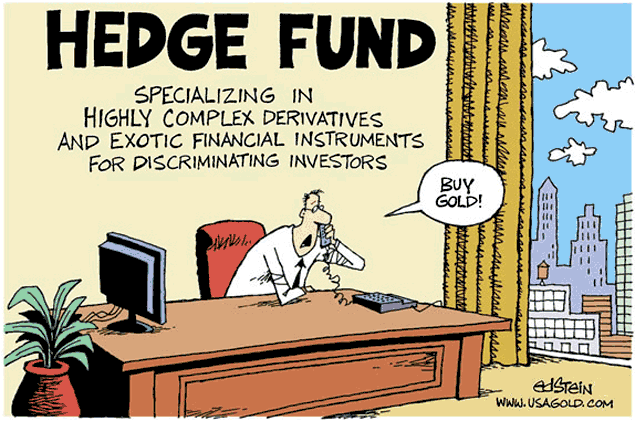
Gold’s parabolic rise remains intact
Gold, the old saying goes, likes to take the stairs up and the elevator down. The first chart (shown below) illustrates the process. Since its most recent elevator drop which began towards the end of February, gold seems to have consolidated at least for now above the $1275-$1285 support zone.
Technical analyst Clive Maund sees the recent drop as part of a larger process – a parabolic rise as illustrated in our second chart. “The rather sharp drop in gold late last week,” he says, “especially on Friday, came as something as a shock to many investors in the sector, yet as we will proceed to see it was set up to react back here or soon, and a period of consolidation or reaction at around this level will actually put it in a better technical condition to mount a sustainable breakout above the key $1400 level. On its latest 7-month chart the 1st point to observe is that gold is still well within our parabolic uptrend, whose lower boundary is coming into play and providing support, as is the rising 50-day moving average, with additional support being generated by premature sellers in the small Pennant pattern that formed during the first half of January. This is why it closed well off the lows on Friday, and why it could now resume the upward path again soon . . .” (Please see his Gold Market Update for the full analysis.)
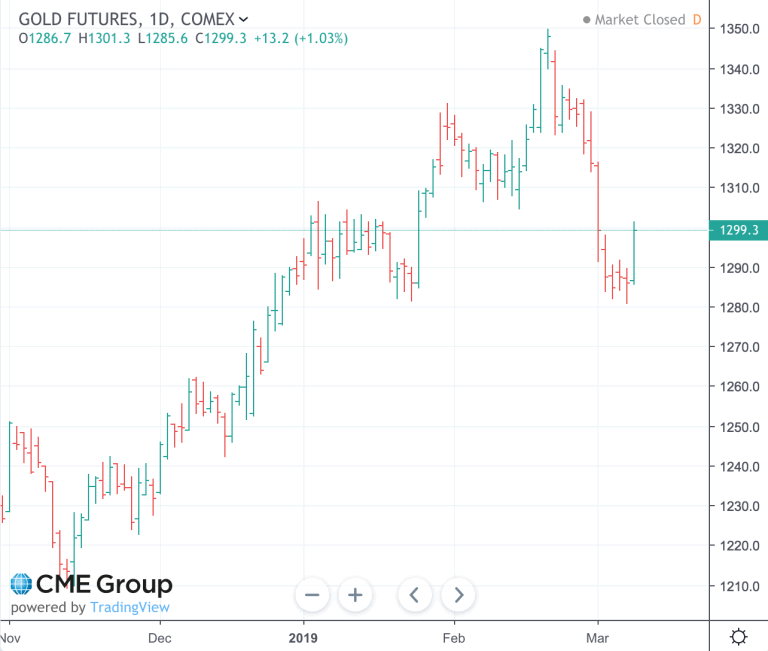
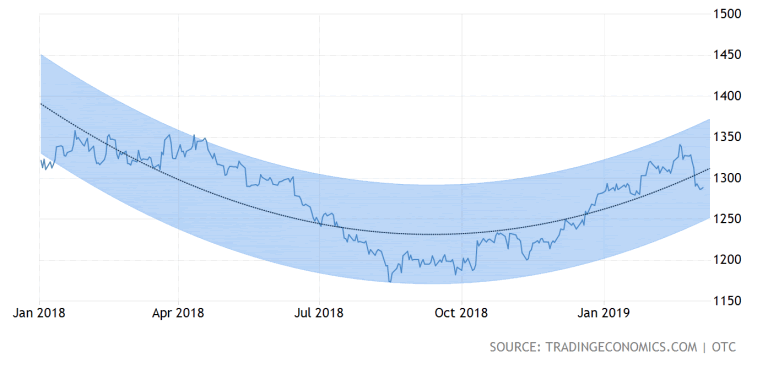
Chart courtesy of TradingEconomics.com
The return of quantitative easing
Suddenly, investors are returning to a safe-haven mindset following reports of abrupt slowdowns in both China and Europe. The central banks of both countries have moved quickly to announce stimulus measures and support for their banking systems in policy U-turns reminiscent of past quantitative easing programs. Those announcements, rather than instilling confidence in the markets, created a sense that the oft-predicted global slowdown might actually have begun. The economic gloom gained momentum when the Labor Department released a jobs report, suggesting that the U.S. economy might be slowing as well. Gold and silver responded immediately with surprisingly strong price advances.
“The global picture continues to be quite concerning,” Columbia Threadneedle’s Gene Tannuzzo told Bloomberg recently. “Europe might be on the edge of recession now, and China has had the slowest growth in a decade. If that continues, there will certainly be an impact to the U.S. economy and we could possibly see QE in 2020.”
Along these lines, Fed vice chairman Richard Clarida resurrected the specter of quantitative easing for the United States in a late February speech. “[T]he FOMC could,” he said, “establish a temporary ceiling for Treasury yields at longer maturities by standing ready to purchase them at a preannounced floor price.” In a Bloomberg article, Interest Rate Observer’s James Grant said that the Fed vice chair’s speech “acknowledged no doubts that radical monetary policy has worked, that it will continue to work and that it may well become more radical.” Clarida, he says, “was pushing no novel agenda of his own” and that his views were “institutional.”
Worry about the return of your money, not just the return on it
“To be fair, the fiscal side of our current system has been nonexistent. We’re not all dead, but Keynes certainly is. Until governments can spend money and replace the animal spirits lacking in the private sector, then the Monopoly board and meager credit growth shrinks as a future deflationary weapon. But investors should not hope unrealistically for deficit spending any time soon. To me, that means at best, a ceiling on risk asset prices (stocks, high yield bonds, private equity, real estate) and at worst, minus signs at year’s end that force investors to abandon hope for future returns compared to historic examples. Worry for now about the return of your money, not the return on it. Our Monopoly-based economy requires credit creation and if it stays low, the future losers will grow in number.”
Bond-fund guru Bill Gross posted that piece of advice in his Investment Outlook column back in 2016. It still applies today – maybe even more so now than it did then. In the wealth game, emphasize defense when you need to, offense when it makes sense. At all times, remain diversified. And by that, we mean real diversification in the form of physical gold and silver coins and/or bullion outside the current fiat money system. There is nothing wrong with owning stocks and bonds. Realize though that these assets are denominated in the domestic currency. If it erodes in value, the underlying value of those assets erodes along with it. A proper diversification addresses that problem now and in the future. Bill Gross, by the way, has recommended buying gold on a number of occasions over the years.
Ignoring America’s abyss of debt
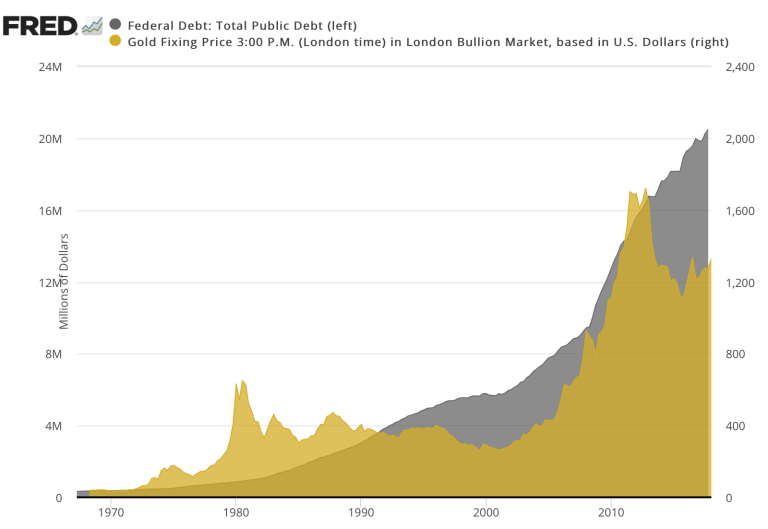
“The United States isn’t Greece,” says The American Conservative‘s Barbara Boland, “but its fiscal condition is worsening and right now there’s no willpower to make it any better. This was expressed with brutal honesty by President Trump, who admitted in December that the prospect of a debt crisis doesn’t bother him because ‘I won’t be here’ when it blows up.” Unfortunately, that has been the attitude among politicians since most of us can remember and precisely why we are in the position in which we find ourselves today. There is a direct long-term correlation between the federal debt and gold expressed in the chart above. There might not be a political remedy at the moment to deficit financing and the dangers it imposes, but happily, there are defensive measures one can apply within his or her personal finances.
“Silver, not gold, is the portfolio insurance to buy now”
So read the headline for a recent MarketWatch article on silver. We at USAGOLD have long advocated adding silver to the mix for portfolio insurance purposes especially at times like the present when the silver-gold ratio is high (now 85 to 1). At the same time, we do not advocate silver to the exclusion of gold, but more as an adjunct through which the investor conceivably can get more bang for his or her buck, if silver outperforms gold to the upside.
Meanwhile, the U.S. Mint has once again shut down production of the popular silver American Eagles after a surge of demand since the start of the year. Coin World reports that “Market fluctuations have resulted in a temporary sellout of 2018 and 2019 silver bullion. Production at the Mint’s West Point facility continues, and when sales resume, silver bullion will be offered under allocation. The Mint is working closely with its suppliers in order to meet the demand of its authorized purchasers.”
Posted sales for February are 2,157,500 one-ounce American Silver Eagles after 4,017,500 in sales for January. The combined months surpass the first two months of 2018 by a substantial margin and indicate rising interest among investors. As of this writing, USAGOLD has ample supply and our pricing has not yet been affected. That, though, is subject to change without notice. In the past instances of U.S. Mint suspensions and allocation programs, premiums have moved higher – sometimes overnight and without any prior warning.
NotableQuotable
“If you look at the history of currency, gold has a unique role and I don’t think it’s accidental. Some people say that if gold hadn’t been selected as a currency thousands of years ago, it would not have a role today. I don’t agree. Gold has a lot of useful properties and unique features so I don’t think its status is in any way accidental. It’s a monetary asset and I think if you replayed history another way, you would come out with gold again.” – Ken Rogoff, Harvard University (World Gold Council, 2-12-2019, The curse of cash and the allure of gold)
“There are certainly forms of instability that have been introduced by algorithmic trading that will increase as we put more and more faith in these algorithms. The February 2018 flash crash was instructive. The culprit was a slightly esoteric exchange-traded product that has a rebalancing mechanism inside of it. And that rebalancing mechanism ended up destroying the product on one specific day when the market moved a little bit more than the product was designed to handle. The product was required to trade a lot of instruments in response to that move. But then those trades exaggerated a small move and it became a big move, which required more rebalancing—and everything spiraled out of control.” – Anonymous algo-trader, LOGIC
“I want a strong dollar but I want a dollar that does great for our country, not a dollar that’s so strong that it makes it prohibitive for us to do business with other nations and take their business.” – President Donald Trump, recent speech before the Conservative Political Action Caucus
“There are those who are persuaded that some new price-enhancing circumstance is in control, and they expect the market to stay up and go up, perhaps indefinitely. Then there are those, superficially more astute and generally fewer in number, who perceive or believe themselves to perceive the speculative mood of the moment. They are in to ride the upward wave; their particular genius, they are convinced, will allow them to get out before the speculation runs its course. They will get the maximum reward from the increase as it continues; they will be out before the eventual fall. For built into this situation is the eventual and inevitable fall. Built in also is the circumstance that it cannot come gently or gradually. When it comes, it bears the grim face of disaster. That is because both of the groups of participants in the speculative situation are programmed for sudden efforts at escape.” – John Kenneth Galbraith, A Short History of Financial Euphoria, 1990 (With thanks to John Hussman, Hussman Funds)
“If gold is anything to go by, investors are increasingly anxious about the state of the world. Volatile equity markets and fears of a global economic slowdown have helped gold rally 10 percent from its August lows, putting it among the best performing metals over that period. It is a sharp contrast to much of the past two years . . . . “ – Henry Sanderson and Neil Hume, Financial Times
“Treasury traders are bracing for their own outbreak of March Madness, with a plethora of risks on the radar, including the coming reinstatement of the U.S. debt ceiling.” – Liz McCormick and Alex Harris, Bloomberg
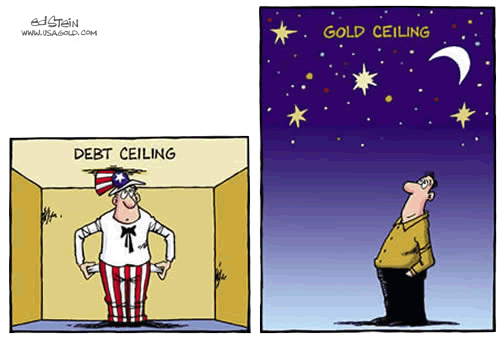
“Financial markets have short memories. Of late, they’ve convinced themselves that collateralized loan obligations (CLOs) are much safer instruments than the collateralized debt obligations, or CDOs, on which they’re based and which helped precipitate the 2008 crisis. They’re wrong — and dangerously so.” – Satyajit Das, Bloomberg Opinion columnist
Editor’s note: No one knew much about CLOs until Janet Yellen brought up the subject about a month ago. Now they have evolved to a major concern particularly because they have the look and feel of mortgage-backed securities – the financial instrument that wreaked havoc in 2008 and ended up comprising a large portion of the Fed’s now hefty balance sheet. They got there as part of the Fed’s bailout of the financial system. Das does a good job of outlining the problem with CLOs in the article linked above under the headline, The bomb that blew up in 2008? We’re planting another one.
“In 1971, Richard Nixon had a problem. The US economy was pretty strong and the Fed wanted to tighten. But Nixon had an election to win in 18 months, and he needed loose monetary policy to do that. Also, the global economy wasn’t that strong, and the rest of the world needed an expanding supply of dollars and an expanding US trade deficit to keep its motor running. Nixon didn’t really care about that, but a lot of his oligarch cronies did.” – Ben Hunt, Epsilon Theory
Editor’s note: It has been said so often it has become a cliche: “History does not repeat itself, but it often rhymes.” (Mark Twain) Ben Hunt offers a quick reprise of the relationship between Richard Nixon and Fed chair Arthur Burns in the early 1970s just before the inflation rate began slipping into double-digits. He points out striking similarities between the Nixon-Burns relationship and the Trump-Powell relationship.
“Had America stuck with real, gold-backed money… and/or had the Fed not supported Wall Street with ultra-low interest rates and $4 trillion of new money… the situation would be much different. There would be no trade deficit with China. There would be no $250 trillion in debt. An F-150 would probably cost less than it did in 1971, not more. The working class would have nothing to grumble about… And Donald Trump would not be president. The Fed would not be ‘normalizing,’ because it never would have un-normalized. The rich would not be so rich. The Dow would not be over 25,000. The government would not have $22 trillion of debt itself. And we wouldn’t be up at 6 a.m. writing this Diary.” – Bill Bonner, Bonner & Partners
“The dilemma today – as it’s been with great inflationary episodes throughout history – is that inflation becomes deeply ingrained and halting it too painful. Policymakers refuse to accept mistakes and change directions. Instead, there is denial and the irresistibility of rationalization and justification. Throughout the devastating Weimar hyperinflation, Germany’s central bank refused to accept that they were the party of primary responsibility – but instead rationalized the bank was being forced to respond to outside forces. Today’s great global inflation is characterized by contrasting dynamics, but some of the devastating consequences of failing to recognize the essence of the problem are all too similar. Markets. Social. Political. Economic. Geopolitical.” – Doug Noland, Credit Bubble Bulletin
“This column has contended for several years, based on empirical data observations from several countries, that low interest rates worldwide were killing productivity growth. A University of Chicago paper finally provides some academic back-up for this contention and suggests a mechanism through which it takes place. There are other mechanisms also, and I would suggest that the Ben Bernanke-inspired wild monetary experimentation from 2008 on has done more damage to the world economy than any other initiative in the history of mankind.” – Martin Hutchinson, The Bear’s Lair

A word on USAGOLD – USAGOLD ranks among the most reputable gold companies in the United States. Founded in the 1970s and still family-owned, it is one of the oldest and most respected names in the gold industry. USAGOLD has always attracted a certain type of investor – one looking for a high degree of reliability and market insight coupled with a professional client (rather than customer) approach to precious metals ownership. We are large enough to provide the advantages of scale, but not so large that we do not have time for you. (We invite your visit to the Better Business Bureau website to review our five-star, zero-complaint record. The report includes a large number of verified customer reviews.)
By Michael J. Kosares
Michael J. Kosares , founder and president
USAGOLD - Centennial Precious Metals, Denver
Michael J. Kosares is the founder of USAGOLD and the author of "The ABCs of Gold Investing - How To Protect and Build Your Wealth With Gold." He has over forty years experience in the physical gold business. He is also the editor of Review & Outlook, the firm's newsletter which is offered free of charge and specializes in issues and opinion of importance to owners of gold coins and bullion. If you would like to register for an e-mail alert when the next issue is published, please visit this link.
Disclaimer: Opinions expressed in commentary e do not constitute an offer to buy or sell, or the solicitation of an offer to buy or sell any precious metals product, nor should they be viewed in any way as investment advice or advice to buy, sell or hold. Centennial Precious Metals, Inc. recommends the purchase of physical precious metals for asset preservation purposes, not speculation. Utilization of these opinions for speculative purposes is neither suggested nor advised. Commentary is strictly for educational purposes, and as such USAGOLD - Centennial Precious Metals does not warrant or guarantee the accuracy, timeliness or completeness of the information found here.
Michael J. Kosares Archive |
© 2005-2022 http://www.MarketOracle.co.uk - The Market Oracle is a FREE Daily Financial Markets Analysis & Forecasting online publication.



